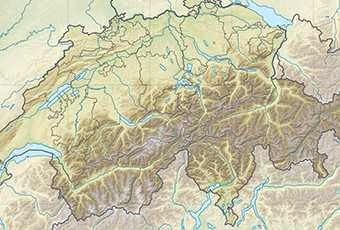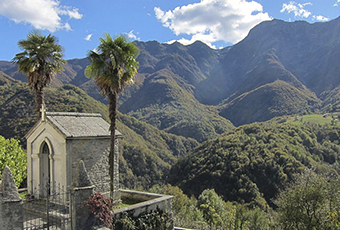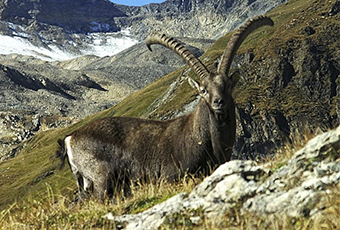Overview

Extending across the north and south side of the Alps in west-central Europe, Switzerland encompasses a great diversity of landscapes and climates on a limited area of 41,285 square kilometres (15,940 sq mi). The population is about 8 million, resulting in an average population density of around 195 people per square kilometre (500/sq mi). The more mountainous southern half of the country is far more sparsely populated than the northern half.[41] In the largest Canton of Graubünden, lying entirely in the Alps, population density falls to 27 /km² (70 /sq mi).
Switzerland lies between latitudes 45° and 48° N, and longitudes 5° and 11° E. It contains three basic topographical areas: the Swiss Alps to the south, the Swiss Plateau or Central Plateau, and the Jura mountains on the west. The Alps are a high mountain range running across the central-south of the country, comprising about 60% of the country's total area. The majority of the Swiss population live in the Swiss Plateau. Among the high valleys of the Swiss Alps many glaciers are found, totalling an area of 1,063 square kilometres (410 sq mi). From these originate the headwaters of several major rivers, such as the Rhine, Inn, Ticino and Rhône, which flow in the four cardinal directions into the whole of Europe. The hydrographic network includes several of the largest bodies of freshwater in Central and Western Europe, among which are included Lake Geneva (also called le Lac Léman in French), Lake Constance (known as Bodensee in German) and Lake Maggiore. Switzerland has more than 1500 lakes, and contains 6% of Europe's stock of fresh water. Lakes and glaciers cover about 6% of the national territory. The largest lake is Lake Geneva, in western Switzerland shared with France. The Rhône is both the main source and outflow of Lake Geneva. Lake Constance is the second largest Swiss lake and, like the Lake Geneva, an intermediate step by the Rhine at the border to Austria and Germany. While the Rhône flows into the Mediterranean Sea at the French Camarque region and the Rhine flows into the North Sea at Rotterdam in the Netherlands, about 1000 km apart, both springs are only about 22 km apart from each other in the Swiss Alps.
48 of Switzerland's mountains are 4,000 metres (13,000 ft) above sea in altitude or higher. At 4,634 m (15,203 ft), Monte Rosa is the highest, although the Matterhorn (4,478 m or 14,692 ft) is often regarded as the most famous. Both are located within the Pennine Alps in the canton of Valais. The section of the Bernese Alps above the deep glacial Lauterbrunnen valley, containing 72 waterfalls, is well known for the Jungfrau (4,158 m or 13,642 ft) Eiger and Mönch, and the many picturesque valleys in the region. In the southeast the long Engadin Valley, encompassing the St. Moritz area in canton of Graubünden, is also well known; the highest peak in the neighbouring Bernina Alps is Piz Bernina (4,049 m or 13,284 ft).
The more populous northern part of the country, comprising about 30% of the country's total area, is called the Swiss Plateau. It has greater open and hilly landscapes, partly forested, partly open pastures, usually with grazing herds, or vegetables and fruit fields, but it is still hilly. There are large lakes found here and the biggest Swiss cities are in this area of the country.


